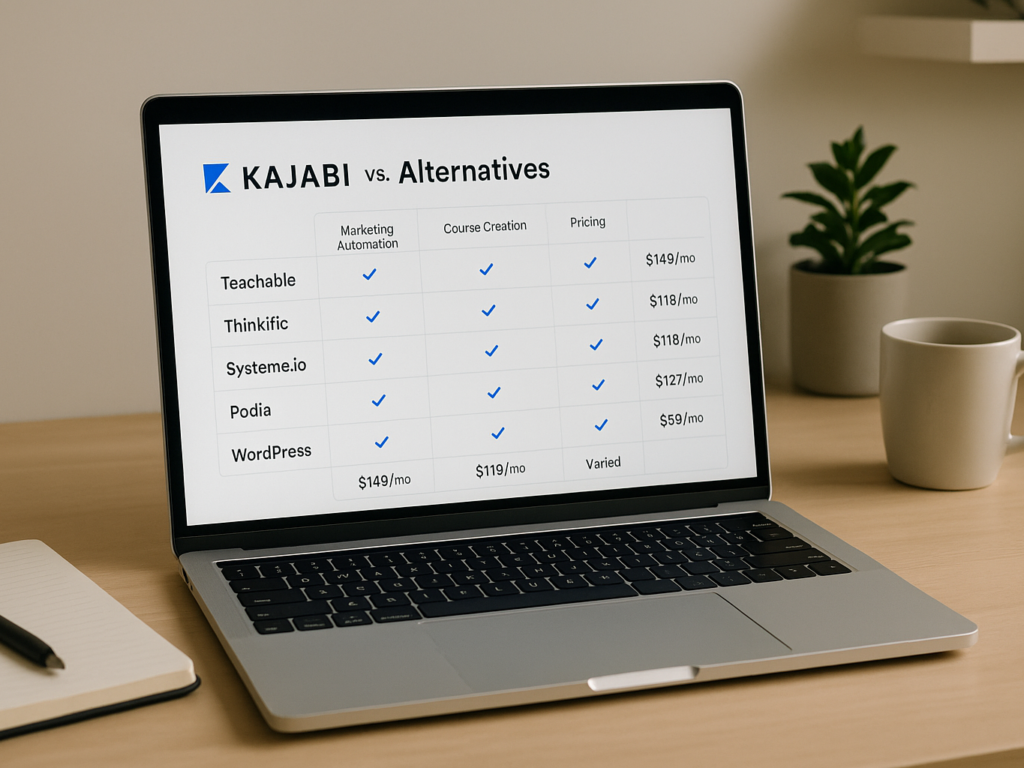The rise of online courses and digital products is booming. Kajabi promises to help you build, market, and sell all in one place.
There’s never been a better time to monetize your expertise in today’s digital landscape. Coaches, consultants, authors, and creators are diving into e-learning, projected to hit $457.8 billion by 2026 (Research and Markets). With that kind of growth, finding a platform that removes tech headaches is key, so enter Kajabi.
But what is Kajabi, and is it the right platform for your online business? This comprehensive guide will walk you through everything you need to know about this popular all-in-one platform, from its core features and pricing to honest reviews and alternatives, so you can decide whether Kajabi deserves a place in your business toolkit.
By the end, you’ll know whether Kajabi is the right platform for your business or personal brand.
What Is Kajabi?

Kajabi is a comprehensive all-in-one business platform designed specifically for knowledge entrepreneurs, course creators, coaches, and content marketers who want to monetize their expertise. Unlike other tools focusing on just one aspect of online business (like course hosting or email marketing), Kajabi integrates everything you need to create, market, and sell digital products under one roof.
“Kajabi has revolutionised the way knowledge entrepreneurs run their businesses,” says Melissa Griffin, a digital marketing strategist who has helped over 200 course creators launch their online platforms. “Before Kajabi, creators were piecing together 5-7 different software tools, dealing with integration issues, and paying multiple subscriptions. Now they have everything centralised, saving money and significantly reducing the technical overwhelm.”
At its core, Kajabi provides the infrastructure to:
- Build professional websites and landing pages
- Create and host online courses, membership sites, and digital products
- Execute email marketing campaigns
- Design and implement sales funnels
- Process payments securely
- Automate customer journeys
- Track business analytics and performance
What sets Kajabi apart is that it eliminates the need to combine various tools like WordPress, LearnDash, MailChimp, Clickfunnels, and payment processors. Everything works seamlessly within the Kajabi ecosystem, making it particularly attractive to non-technical entrepreneurs who want to focus on creating content rather than dealing with technical integrations.
Kajabi Courses: How Course Creation Works
The course creation functionality remains one of Kajabi’s most compelling features. As highlighted in the eLearning Industry, creating engaging online courses has become essential for knowledge entrepreneurs seeking to scale their impact and income.
Creating a course in Kajabi follows a structured, intuitive process:
- Product Blueprint Selection: Choose from pre-designed course structures like mini-courses, online courses, or drip-fed memberships.
- Content Organisation: Arrange your material into categories (called “categories” in Kajabi), subcategories (“posts”), and lessons.
- Content Upload: Add videos, PDFS, audio files, quizzes, and other content types to build out your lessons.
- Appearance Customisation: Style your course with branding elements, colors, and fonts.
- Access Settings: Configure enrollment options, pricing, and access restrictions (one-time purchase, subscription, or membership).
What makes Kajabi courses stand out is the professional presentation and user experience. Students get a clean, distraction-free learning environment with progress tracking, comments, and community features.
“The ability to create immersive learning environments is crucial for student success and completion rates,” explains Dr. Jonathan Reeves, an educational technology researcher. “Kajabi’s course platform creates what we call ‘learning stickiness’, an environment where students are more likely to complete courses because the experience feels cohesive and professional, unlike cobbled-together solutions that can feel disjointed.”
Kajabi’s course functionality includes:
- Drip scheduling: Release content on a timed schedule to prevent overwhelm
- Assessments and quizzes: Test comprehension and engagement
- Certificates: Reward completion with customizable certificates
- Community forums: Foster student interaction and support
- Engagement tracking: See which students are active and which need attention
With these tools, course creators can focus on delivering value rather than wrestling with technology. According to a TechJury report, courses with interactive elements and community features have significantly higher completion rates, something Kajabi has built into its core functionality.
Key Features Overview
Kajabi offers a robust suite of tools that replace multiple standalone services. Here’s a breakdown of its key features:
| Feature | Description |
| Website Builder | Drag-and-drop builder to create professional websites, landing pages, and blogs without coding. |
| Sales Funnels | Built-in pipelines to guide visitors through your offers and convert them into paying customers. |
| Email Marketing | Integrated email system with automation, segmentation, and broadcast features for campaigns. |
| Payment Integrations | Seamless payments via Stripe and PayPal with subscription options, one-time offers, and upsells. |
| Analytics | Real-time insights into user behavior, revenue, and email performance to make data-driven decisions. |
| Podcast Hosting | Host and distribute your podcast directly from Kajabi with RSS feeds and episode scheduling. |
| Automations | Trigger-based workflows to send emails, unlock content, or tag users based on behavior. |
The real power of Kajabi comes from how these features work together. For instance, when someone purchases your course, they’re automatically added to your CRM, enrolled, and tagged appropriately. They can trigger an automated email sequence without you lifting a finger.
According to a HubSpot study, businesses using integrated marketing platforms see up to 38% higher sales productivity. This integration is where Kajabi shines compared to using separate tools for each function.
Kajabi Pricing (2025 Update)
One of the most common questions about Kajabi is whether it’s worth the investment, as it’s priced at a premium compared to some alternatives. Here’s the current Kajabi pricing structure as of 2025:
1. 💸 Kajabi Pricing Plans Comparison
| Feature | Basic | Growth | Pro |
| Monthly Price | $149/mo | $199/mo | $399/mo |
| Products | 3 | 15 | 100 |
| Pipelines | 3 | 15 | 100 |
| Contacts | 10,000 | 25,000 | 100,000 |
| Websites | 1 | 1 | 3 |
| Admin Users | 1 | 10 | 25 |
| Advanced Automations | ❌ | ✅ | ✅ |
| Affiliate Program | ❌ | ✅ | ✅ |
| Code Editor Access | ❌ | ❌ | ✅ |
| White Labeling | ❌ | ❌ | ✅ |
| 0% Kajabi Transaction Fees | ✅ | ✅ | ✅ |
| Unlimited Emails & Landing Pages | ✅ | ✅ | ✅ |
| Webinars, Events, Assessments | ✅ | ✅ | ✅ |
| 24/7 Customer Support | ✅ | ✅ | ✅ |
2. What are Kajabi’s Pricing Plans (What You Get)
Kajabi keeps it simple with three main plans, whether you’re just starting or scaling up like a pro.
(i) Basic Plans: $149/month ($119/month if billed annually)
Perfect for solopreneurs dipping their toes into the digital product world.
- Create up to 3 products and three pipelines.
- Grow with up to 10,000 contacts.
- Manage one website with one admin user.
- All the essentials, minus the fluff
- No transaction fees, just processor charges
(ii) Growth Plan: $199/month ($159/month if billed annually)
Best for small teams who are ready to scale up and want more muscle behind their marketing.
- Launch 15 products and 15 pipelines.
- Expand your reach with 25,000 contacts.
- Same one website, but now with 10 admin users
- Unlock advanced automations + a full affiliate program.
(iii) Pro Plan: $399/month ($319/month if billed annually)
Built for established brands and power users who want total control.
- Flex with 100 products and 100 pipeline
- Handle up to 100,000 contacts.
- Host 3 websites with 25 admin users
- Access the code editor for deep customization.
- Enjoy white labeling (bye-bye Kajabi branding)
Every Plan Includes
- 0% Kajabi transaction fees
- Unlimited landing pages & emails
- Webinars, assessments, and events
- 24/7 customer support that helps
As noted by ProductHunt, Kajabi pricing puts it at the higher end of the market, but users need to consider what they’re getting, the equivalent of 5+ tools bundled into one. When you factor in what you’d pay for separate course platforms, email marketing, website hosting, sales funnel software, and membership site tools, Kajabi often becomes cost-effective for serious creators.
For entrepreneurs just starting, the pricing can be a hurdle. However, Kajabi occasionally offers extended free trials (usually 14-30 days) that allow you to test the platform before committing.
Kajabi Review: Is It Worth It?
After working with dozens of online course platforms, here’s my honest assessment of Kajabi’s strengths and limitations:
Pros:
- All-in-One Solution: The primary advantage is having everything under one roof—no more wrestling with integrations or jumping between platforms to manage your business.
- Professional Look and Feel: Kajabi sites and courses look polished and professional without requiring design skills. This perceived value can justify higher prices for your products.
- Robust Marketing Tools: The email marketing, pipeline, and automation features rival standalone marketing platforms, allowing sophisticated marketing without additional tools.
- No Transaction Fees: Unlike platforms like Teachable, which charge transaction fees on some plans, Kajabi only requires you to pay standard payment processor fees.
- Excellent Customer Support: 24/7 support via chat and extensive documentation make troubleshooting easier, even for non-technical users.
Cons:
- Steep Learning Curve: While powerful, KKajabi’s many features can overwhelm beginners. Expect to invest time in learning the platform.
- Premium Price Point The starting price of $149/month is substantial for beginners or those with smaller audiences.
- Limited Customization Without Code. While Kajabi offers good customization options, those wanting highly unique designs may find the templates somewhat limiting without custom code.
- Overkill for Simple Needs. If you want to sell a single course without marketing bells and whistles, Kajabi might be more than you need.
Ryan Levesque, CEO of Choose.co and bestselling author of “Ask,” shares: “For serious knowledge entrepreneurs, Kajabi isn’t an expense, it’s an investment. The businesses I’ve seen thrive with Kajabi leverage its full ecosystem rather than just using it as a course host. The ROI quickly becomes obvious when you embrace the entire platform, from lead generation to customer ascension.”
Kajabi Alternatives: How It Stacks Up
When choosing a platform for your online courses and digital products, understanding how Kajabi compares to alternatives is crucial for making the right decision for your business needs.
Quick Comparison Table
| Feature | Kajabi | Teachable | Thinkific | Systeme.io | Podia | WordPress + Plugins |
| Starting Price | $149/mo | $39/mo | $39/mo | $27/mo | $39/mo | $15-30/mo + plugins |
| All-in-One Solution | ✅ | ❌ | ❌ | ✅ | ✅ | ❌ |
| Course Builder | Advanced | Good | Advanced | Basic | Good | Varies by plugin |
| Marketing Tools | Comprehensive | Limited | Limited | Good | Basic | Requires plugins |
| Email Marketing | Built-in | ❌ | ❌ | Built-in | Basic | Requires plugins |
| Landing Pages | Unlimited | Limited | Limited | Yes | Yes | Requires plugins |
| Transaction Fees | None | 5% (basic plan) | None | None | None | Varies by plugin |
| Mobile App | ✅ | ✅ | ❌ | ❌ | ❌ | Depends |
| Community Features | Advanced | Basic | Good | Basic | Good | Requires plugins |
Comparing Kajabi with Alternatives
1. Kajabi vs. Teachable
Teachable offers an affordable entry point and simple course setup, but lacks Kajabi’s comprehensive marketing suite. While Teachable focuses primarily on course delivery, Kajabi provides a business ecosystem with funnels, email automation, and pipelines. Teachable works best for educators with existing marketing tools.
2. Kajabi vs. Thinkific
Regarding Kajabi alternatives, Thinkific stands out for its robust course design tools and generous free plan, which are perfect for beginners just getting started. While it offers excellent flexibility in course creation, it lacks Kajabi’s all-in-one marketing and automation features. Thinkific users often rely on third-party apps to match the seamless marketing workflows Kajabi provides, making it less convenient for those seeking an all-inclusive platform.
3. Kajabi vs. Systeme.io
Systeme.io delivers remarkable value with similar all-in-one functionality at a significantly lower price point. While it includes essentials like funnels and email marketing, its course features and customization options aren’t as sophisticated as Kajabi’s. Perfect for budget-conscious creators who need the basics.
4. Kajabi vs. Podia
Podia offers an intuitive, clean interface with straightforward pricing and no transaction fees. It includes digital downloads, webinars, and community features, but lacks Kajabi’s advanced marketing automation and course engagement tools. Podia is ideal for creators seeking simplicity without technical complexity.
5. Kajabi vs. WordPress + Plugins
Among Kajabi alternatives, WordPress with LMS plugins offers unmatched customization and potentially lower long-term costs. However, setting it up requires technical know-how, as you’ll need to manage multiple plugins and integrations. While it gives you full control and flexibility, WordPress demands significantly more time and effort than Kajabi’s streamlined, ready-to-use experience.
When to Choose Kajabi vs. an Alternative

Choose Kajabi when:
- You want an all-in-one solution with no technical hassle
- Marketing automation and sales funnels are priorities
- You plan to scale to multiple products and offerings
- You value premium student experience and engagement features
- Time saved from integration issues justifies the higher cost
Consider alternatives when:
- You’re on a tight budget (Systeme.io, Podia)
- You need only basic course functionality (Teachable)
- You prioritize course design flexibility (Thinkific)
- You want maximum customization control (WordPress)
- You already have email marketing and other tools in place
The right choice ultimately depends on your business needs, technical comfort level, and budget constraints.
Who Should Use Kajabi (And Who Shouldn’t)?
Kajabi Is Ideal For:
1. Established Coaches and Consultants
If you’re already generating revenue and want to scale your business with courses, memberships, or digital products, Kajabi provides everything you need in one place.
2. Digital Product Creators With Multiple Offerings
With the ability to create various products and funnels, Kajabi works well for creators with diverse offerings.
3. Non-Technical Entrepreneurs
If you value time over money and don’t want to deal with the technical aspects of running your online business, Kajabi’s all-in-one approach is perfect.
4. Businesses Focused on Growth
The robust marketing tools make Kajabi excellent for those who build email lists and create sophisticated sales funnels.
Kajabi Isn’t Ideal For:
1. Complete Beginners on a Tight Budget
If you’re testing the waters and unsure about making a significant investment, Kajabi’s price point may be prohibitive.
2. Simple One-Course Businesses
Simpler and less expensive platforms might be more appropriate if you sell just one course with minimal marketing.
3. Highly Customized Website Needs
Those requiring very specific designs or functionalities might find Kajabi’s templates limiting compared to a custom WordPress setup.
4. Physical Product-Focused Businesses
While Kajabi can sell digital products brilliantly, it’s not designed for physical product e-commerce.
Final Thoughts: Is Kajabi Right For Your Business?
Kajabi represents a significant evolution in how knowledge entrepreneurs run their online businesses. Rather than combining multiple tools or hiring developers, it provides a unified ecosystem where everything works seamlessly. This integration is its greatest strength and the justification for its premium price.
When evaluating whether Kajabi is right for you, consider these questions:
- Are you spending too much time managing multiple tools rather than creating content and serving customers?
- Is your current tech stack costing you close to or more than Kajabi’s monthly fee?
- Do you value an integrated approach over the flexibility of mixing and matching different tools?
- Are you planning to scale beyond just a single course or product?
If you answered yes to most of these questions, Kajabi likely represents good value for your business, despite the higher initial investment. The platform continues to evolve with regular updates and new features, making it a future-proof choice for serious online entrepreneurs.
Ready to explore whether Kajabi is right for your business? Please take advantage of their extended 30-day free trial to test all the features without commitment. The best way to understand if Kajabi fits your needs is to build a sample product, test the marketing tools, and experience the all-in-one environment firsthand. Visit Kajabi’s official website today to start your free trial and see if this powerful platform is the solution your business needs to scale to the next level.
FAQs on What is Kajabi
Q1. Is Kajabi good for beginners?
While Kajabi is user-friendly, its comprehensive nature and price point make it better suited for established entrepreneurs or those with a clear business plan rather than absolute beginners testing the waters.
Q2. Can I sell physical products on Kajabi?
Kajabi is primarily designed for digital products. While you can create offers for physical products, they lack inventory management and shipping features in dedicated e-commerce platforms.
Q3. Does Kajabi charge transaction fees?
No, Kajabi doesn’t charge additional transaction fees on sales. You’ll only pay the standard fees from payment processors like Stripe or PayPal (typically around 2.9% + $0.30 per transaction).
Q4. Can I migrate my existing courses to Kajabi?
Yes, Kajabi offers migration assistance for Pro plan members. For other plans, you’ll need to manually recreate your courses, though the process is relatively straightforward.
Q5. Is Kajabi SEO-friendly?
Yes, Kajabi provides basic SEO tools, including customizable meta descriptions, titles, and URLs. While not as robust as WordPress SEO plugins, it covers the essentials for good search visibility.





